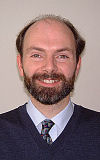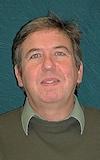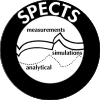Program Committee
General Chair
Mohammad S. Obaidat
Monmouth Univ., NJ, USA
Program Chairs
Jose Marzo
Univ. of Girona, Spain
Helena Szczerbicka
Univ. of Hannover, Germany
Program Vice Chairs
Pawel Gburzynski
Univ. of Alberta, Canada
JosÚ Luis Sevillano
Univ. of Seville, Spain
Tutorials and Special Sessions Chair
S. Dharmaraja
Indian Institute of Technology, Delhi, India
Awards Chair
Franco Davoli
Univ. of Genoa, Italy
Publicity Committee
Essia Elhafsi
Univ. of California-Riverside, USA (Chair)
Jong Hyuk Park
Kyungnam Univ., Korea
Farid Na´t-Abdesselam
Univ. of Sciences & Technologies of Lille, France
Abdelmajid Khelil
Technical Univ. of Darmstadt, Germany
Local Arrangement Chair
Graham Shanks
Baesystems, UK
Webmasters
Antonio Bueno
Univ. of Girona, Spain
Michael J. Chinni
US Army TACOM-ARDEC
Publication Chair
Pere VilÓ
Univ. of Girona, Spain
SPECTS 2008 Keynote I
Quality of experience: the route to scalable performance evaluation of networked systems?
Prof. Jonathan Pitts, Networks Research, Queen Mary, University of London

As computer simulation technologies enable larger, and more complex, networked systems to be modelled on high-end computing (HEC) resources within reasonable timeframes, the methodological challenges (e.g. of specifying suitable scenarios, efficiently exploring large-scale states spaces, and effectively summarizing performance) increase. In the context of communication networks, quality of experience (QoE) is a measure of performance that summarizes the end-user's perspective of the service. Perhaps the most well known QoE measure is the Mean Opinion Score (MOS) for conversational quality in telephony service, which has been used extensively in the design and deployment of circuit-switched voice networks. In recent years, an analytical method (called the E-model) has been standardized by the ITU to enable voice quality to be predicted from various parameters describing the voice path across a network. This method generates an R-factor that has a one-to-one mapping to MOS and rates the quality of the voice connection on a scale of 0 to 100. The E-model is being used extensively in VoIP monitoring systems and tools, and there are similar efforts being made to develop equivalent models for combined audio-visual quality metrics.
Thus, when studying the behaviour of converged IP networks, it is possible to report the performance of VoIP service as a single QoE value (the R factor), rather than using multiple measures of the underlying network impairments (i.e. packet loss, latency, jitter). This enables new ways of reporting, and visualizing, whole-of-network performance, and can change the focus of performance evaluation studies. Instead of a classic scenario comprising a tandem network with background cross traffic and a relatively small number of foreground streams for which multiple performance measures are gathered, it is possible to study, for example, an irregularly connected mesh network and measure the QoE across all source-destination paths. This talk describes how whole-of-network QoE measures have been developed that can offer new engineering insight in the study of wired and wireless network scenarios, with illustrations from simulation studies performed on national UK HEC resources.
Jonathan Pitts is Professor of Communication Engineering at Queen Mary, University of London. He received his Ph.D. (London) in 1993, and has been a member of academic staff in the Department of Electronic Engineering at Queen Mary since 1994. In 1998 he was awarded a Royal Academy of Engineering Industrial Secondment to work with Cable & Wireless Communications, and in 2006 a short term research fellowship with British Telecom. His research interests focus on the study, and effective modelling, of communications network behaviour, and how to exploit that understanding to provide both network and service assurance.
SPECTS 2008 Keynote II
From questions to answers via models: Answers to questions?
Prof. Rob Pooley, Heriot-Watt University, Edinburgh

We all agree that systems are becoming far too complex to understand easily in their entirety and that abstraction is the key to managing such complexity. The techniques used in modeling provide abstractions which can answer key questions, so what are the questions about modeling that are left? In fact it often seems that there are more questions than answers.
Put another way, modeling has been an important tool in many areas for four decades or more. Today sees renewed interest in the application of modeling to the understanding of enormously complex systems. Yet, there remain many challenges in making modeling accessible to non-specialists. This talk poses the questions which seem most meaningful at present and attempts to answer some of them. To provide a structure to this, we assume the key questions are essentially unchanged since computer based simulation began and examine how well we can now answer them.
- How can modeling be more accessible?
- How can modeling be more efficient?
- How can we model more complex systems?
Rob Pooley is Professor of Computer Science at Heriot Watt University, Edinburgh. He graduated from the University of Bristol with a BSc an Economics and gained an MSc from the University of Bradford and a PhD from the University of Edinburgh, both in Computer Science. After some years as a High School teacher, he worked as a systems programmer, before joining the faculty at the University of Edinburgh as a Lecturer in Computer Science. As an academic he continued an interest in discrete event simulation and object oriented techniques, which had begun with work in the implementation of the Simula programming language. He was awarded a Chair in Computer Science by Heriot Watt University in 1998.
Rob Pooley has been Chair and Secretary of the UK Simulation Society and an associate editor for the journal Simulation Practice and Theory. He has chaired, programme chaired and been a member of the programme committee of many major conferences in the area of simulation and modeling. In 2005 he was made a fellow of the British Computer Society.
He is the author of three books and over eighty scientific papers in refereed conferences and journals.
Go to the full conference program
